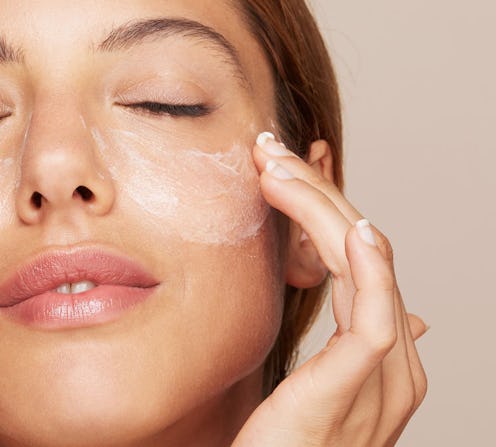Life
You've Probably Been Missing Out This One Vital Spot When You Put SPF On

Over the past year or so, I've tried to ensure that my essential skincare products contain some degree of SPF. Of course, the most common product for sun protection to appear in is moisturiser. But according to a new study, people are not applying SPF moisturiser correctly, missing vital areas that could increase their skin cancer risk.
Researchers at the University of Liverpool asked 62 women and 22 men to apply regular sunscreen and an SPF moisturiser the way they usually would at home. Using a UV-sensitive camera, photos were taken of each participant to see which parts of the face were being adequately protected and which parts were being missed. (The darker the area, the better the protection.)
Results — which were published in the PLOS One journal — showed that typical sunscreen application was missing 11 percent of the face. SPF moisturiser application, however, had a higher percentage with almost 17 percent of the face being missed. The area that showed either no product or a too thin layer tended to be the eyes. In fact, there was 14 percent less sunscreen coverage around the eyelids and 21 percent less SPF moisturiser coverage.
This could be a significant problem, study author Austin McCormick told the BBC, because this is the area most vulnerable to skin cancer. "The eyelid skin is very thin and this puts it at risk of UV damage," he said, adding: "The area around the eyelashes and between the eyelids and the nose is least likely to be covered."
McCormick, who is a consultant ophthalmic and oculoplastic surgeon, also pointed out that, in the UK, eyelid cancers make up 10 percent of the most common type of skin cancer: basal cell carcinoma. What's even more worrying is that, after answering a questionnaire, it was clear that participants had no idea they were partially unprotected.
The research team have a few theories as to why people are missing these vital facial areas. One is the fear of getting product in your eyes. Experts noted that they had previously seen this with sunscreen, but expected such fear to have subsided when it came to moisturiser. Personal experience has taught me that moisturiser in the eyes hurts just as much as sunscreen, so they might want to rethink that one.
Another moisturiser-related factor could be that people don't want to waste what can be an expensive product. Plus, moisturisers do tend to come in small containers, meaning people may be less likely to apply a thick layer.
It's important to remember that an SPF moisturiser will not offer the same level of protection as sunscreen, especially if you're spending hours outside in the sun. "If planning prolonged sun exposure, we advise sunscreen be used," McCormick said in a statement. "If using moisturiser, we advise one with SPF: any SPF is better than none, but it should not be considered the equal of sunscreen."
The British Association of Dermatologists suggests using a sunscreen with an SPF of at least 30. To stay on the safe side in everyday life, apply it 30 minutes before stepping out into the sun and reapply every two hours. If exercising or swimming, reapply immediately afterwards.
If you don't want to apply sunscreen on your eyelids or near your eyes, wear UV filter sunglasses. Alternatively, dermatologist Dr. Anjali Mahto recommends mineral sunscreens containing titanium and zinc for sensitive areas, reports HuffPost.